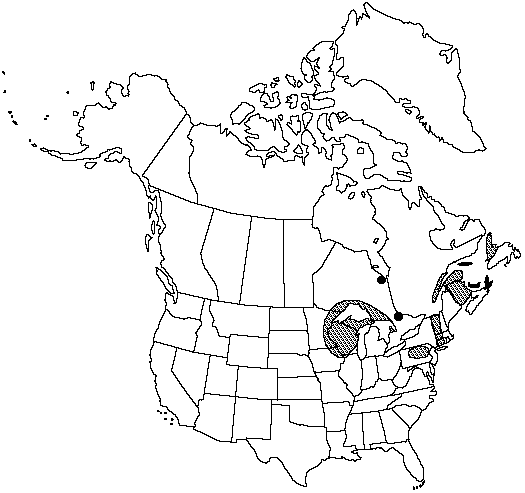Difference between revisions of "Cystopteris laurentiana"
Mem. Torrey Bot. Club 21(4): 51. 1963.
FNA>Volume Importer |
FNA>Volume Importer |
||
| Line 20: | Line 20: | ||
}}<!-- | }}<!-- | ||
| − | --><span class="statement" id="st- | + | --><span class="statement" id="st-undefined" data-properties=""><b>Stems </b>creeping, not cordlike, internodes very short, less than 5 mm, heavily beset with old petiole bases, hairs absent; scales uniformly brown to ± clathrate, radial walls brown, luminae clear. <b>Leaves</b> monomorphic, clustered at stem apex, to 45 cm, nearly all bearing sori. <b>Petiole</b> usually dark at base, grading to straw-colored distally, shorter than blade, sparsely scaly at base. <b>Blade</b> ovate to narrowly ovate, 2-pinnate to 2-pinnate-pinnatifid, widest above base, apex short-attenuate; rachis and costae usually sparsely invested with unicellular, gland-tipped hairs, occasionally with misshapen bulblets; axils of pinnae with occasional multicellular, gland-tipped hairs. <b>Pinnae</b> typically perpendicular to rachis, not curving toward blade apex, margins serrate; proximal pinnae pinnate-pinnatifid to pinnatifid, ± equilateral, basiscopic pinnules not enlarged, basal basiscopic pinnules sessile to short-stalked, base truncate to obtuse; distal pinnae ovate to oblong. <b>Veins</b> directed into teeth and notches. <b>Indusia</b> cup-shaped, apex truncate, typically sparsely invested with unicellular, gland-tipped hairs. <b>Spores</b> spiny, usually 49–60 µm. <b>2n</b> = 252.</span><!-- |
-->{{Treatment/Body | -->{{Treatment/Body | ||
| + | |phenology=Sporulating summer–fall. | ||
|habitat=Cracks and ledges on cliffs, often on calcareous substrates | |habitat=Cracks and ledges on cliffs, often on calcareous substrates | ||
|elevation=0–1000 m | |elevation=0–1000 m | ||
| Line 42: | Line 43: | ||
|basionyms=Cystopteris fragilis var. laurentiana | |basionyms=Cystopteris fragilis var. laurentiana | ||
|family=Dryopteridaceae | |family=Dryopteridaceae | ||
| + | |phenology=Sporulating summer–fall. | ||
|habitat=Cracks and ledges on cliffs, often on calcareous substrates | |habitat=Cracks and ledges on cliffs, often on calcareous substrates | ||
|elevation=0–1000 m | |elevation=0–1000 m | ||
| Line 49: | Line 51: | ||
|publication year=1963 | |publication year=1963 | ||
|special status= | |special status= | ||
| − | |source xml=https://jpend@bitbucket.org/aafc-mbb/fna- | + | |source xml=https://jpend@bitbucket.org/aafc-mbb/fna-data-curation.git/src/9216fc802291cd3df363fd52122300479582ede7/coarse_grained_fna_xml/V2/V2_397.xml |
|genus=Cystopteris | |genus=Cystopteris | ||
|species=Cystopteris laurentiana | |species=Cystopteris laurentiana | ||
| − | |||
| − | |||
| − | |||
| − | |||
| − | |||
| − | |||
| − | |||
| − | |||
| − | |||
| − | |||
| − | |||
| − | |||
| − | |||
| − | |||
| − | |||
| − | |||
| − | |||
| − | |||
| − | |||
| − | |||
| − | |||
| − | |||
| − | |||
| − | |||
| − | |||
| − | |||
| − | |||
| − | |||
| − | |||
| − | |||
| − | |||
| − | |||
| − | |||
| − | |||
| − | |||
| − | |||
| − | |||
}}<!-- | }}<!-- | ||
-->[[Category:Treatment]][[Category:Cystopteris]] | -->[[Category:Treatment]][[Category:Cystopteris]] | ||
Revision as of 13:19, 27 July 2019
Stems creeping, not cordlike, internodes very short, less than 5 mm, heavily beset with old petiole bases, hairs absent; scales uniformly brown to ± clathrate, radial walls brown, luminae clear. Leaves monomorphic, clustered at stem apex, to 45 cm, nearly all bearing sori. Petiole usually dark at base, grading to straw-colored distally, shorter than blade, sparsely scaly at base. Blade ovate to narrowly ovate, 2-pinnate to 2-pinnate-pinnatifid, widest above base, apex short-attenuate; rachis and costae usually sparsely invested with unicellular, gland-tipped hairs, occasionally with misshapen bulblets; axils of pinnae with occasional multicellular, gland-tipped hairs. Pinnae typically perpendicular to rachis, not curving toward blade apex, margins serrate; proximal pinnae pinnate-pinnatifid to pinnatifid, ± equilateral, basiscopic pinnules not enlarged, basal basiscopic pinnules sessile to short-stalked, base truncate to obtuse; distal pinnae ovate to oblong. Veins directed into teeth and notches. Indusia cup-shaped, apex truncate, typically sparsely invested with unicellular, gland-tipped hairs. Spores spiny, usually 49–60 µm. 2n = 252.
Phenology: Sporulating summer–fall.
Habitat: Cracks and ledges on cliffs, often on calcareous substrates
Elevation: 0–1000 m
Distribution

N.B., Nfld., N.S., Ont., Que., Conn., Ill., Iowa, Mass., Mich., Minn., Pa., Vt., Wis.
Discussion
Cystopteris laurentiana is a sexual allohexaploid species with C. bulbifera as the diploid parent and C. fragilis as the tetraploid. Cystopteris laurentiana was previously thought to be common only in the Great Lakes region (R. F. Blasdell 1963); it is now known to occur frequently in the Driftless Area of the Midwest. Because C. laurentiana can be difficult to distinguish from C. fragilis, specimens with ovate leaves having unusually large spores and growing on moist cliffs should be checked carefully for occasional glandular hairs, the distinguishing feature of C. laurentiana. Sterile pentaploid hybrids between C. laurentiana and C. fragilis have been discovered where the two species are sympatric.
Selected References
None.